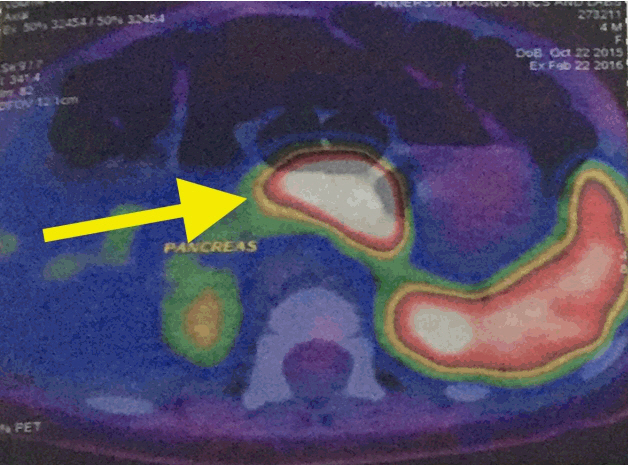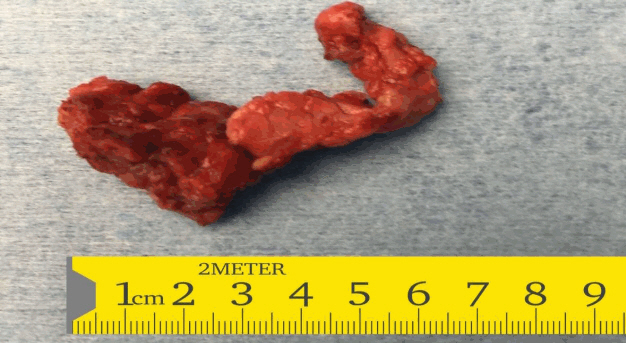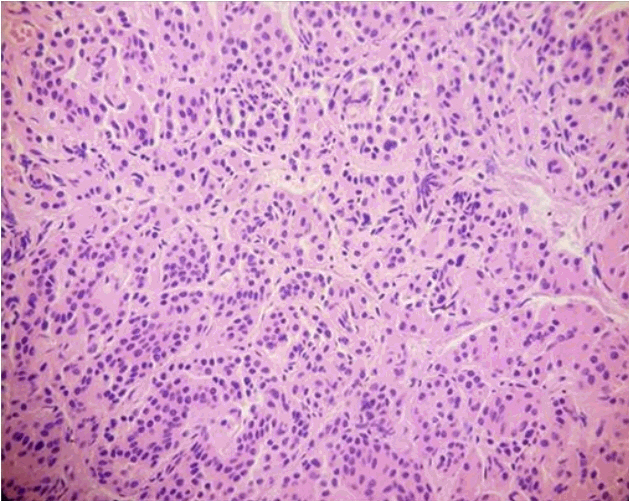Ann Pediatr Endocrinol Metab.
2017 Dec;22(4):272-275. 10.6065/apem.2017.22.4.272.
Congenital hyperinsulinism: diagnostic and management challenges in a developing country – case report
- Affiliations
-
- 1Angels Speciality Clinic, Chennai, India. cherimjohn@gmail.com
- 2Department of Paediatric Surgery, Sri Ramachandra University, Chennai, India.
- 3Anderson Diagnostics and Labs, Chennai, India.
- 4Department of Pathology, Sri Ramachandra University, Chennai, India.
- 5Department of Paediatric Endocrinology, Alder Hey Children’s Hospital, Liverpool, UK.
- KMID: 2400785
- DOI: http://doi.org/10.6065/apem.2017.22.4.272
Abstract
- Management of congenital hyperinsulinemia of infancy (CHI) is challenging. A 4-month-old female infant with persistent hypoglycemia and elevated insulin levels was diagnosed with CHI. Gallium-68 DOTANOC positron emission tomography/computed tomography (PET/CT) scan (â¶â¸Ga-labeled [1,4,7,10-tetraazacyclododecane-N,N',N'',N'''-tetraacetic acid]-1-NaI3-octreotide) demonstrated focal disease in the body of the pancreas. Genetic studies indicated paternal inheritance, making focal disease likely. She was started on diazoxide therapy with partial improvement in blood glucose levels. Due to a suboptimal response to diazoxide and the likelihood of focal disease amenable to surgery, a laparoscopic subtotal pancreatectomy with preservation of the head of the pancreas was performed. The biopsy demonstrated diffuse hyperplastic pancreatic islet cells on immunohistochemistry, indicative of diffuse rather than focal disease. Paternal inheritance is a recognized indicator of focal disease. Gallium-68 DOTANOC PET/CT scan is the only available imaging modality in South India as ¹â¸F-L-dihydroxyphenylalanine (DOPA) PET/CT scan is not available at present. A laparoscopic approach reduces the postoperative recovery time and morbidity in such patients. The absence of ¹â¸F-L-DOPA PET/CT scan and the limited supply of diazoxide makes the management of this complex condition more challenging in developing countries.
Keyword
MeSH Terms
Figure
Reference
-
References
1. Sunehag A, Haymond MW. Pathogenesis, clinical features, and diagnosis of persistent hyperinsulinemic hypoglycemia of infancy [Internet]. Waltham (MA): UpToDate;2016. [2016 Mar 29]. Available from: http://www.uptodate.com/contents/pathogenesis-clinical-features-and-diagnosis-ofpersistent-hyperinsulinemic-hypoglycemia-of-infancy.2. Meissner T, Wendel U, Burgard P, Schaetzle S, Mayatepek E. Long-term follow-up of 114 patients with congenital hyperinsulinism. Eur J Endocrinol. 2003; 149:43–51.
Article3. Kapoor RR, James C, Hussain K. Advances in the diagnosis and management of hyperinsulinemic hypoglycemia. Nat Clin Pract Endocrinol Metab. 2009; 5:101–12.
Article4. Chandran S, Peng FY, Rajadurai VS, Lu YT, Chang KT, Flanagan SE, et al. Paternally inherited ABCC8 mutation causing diffuse congenital hyperinsulinism. Endocrinol Diabetes Metab Case Rep. 2013; 2013:130041.
Article5. de Lonlay-Debeney P, Poggi-Travert F, Fournet JC, Sempoux C, Dionisi Vici C, Brunelle F, et al. Clinical features of 52 neonates with hyperinsulinism. N Engl J Med. 1999; 340:1169–75.
Article6. Desai MP, Khatri JV. Persistent hyperinsulinemic hypoglycemia of infancy. Indian Pediatr. 1998; 35:317–28.7. Glaser B, Hirsch HJ, Landau H. Persistent hyperinsulinemic hypoglycemia of infancy: long-term octreotide treatment without pancreatectomy. J Pediatr. 1993; 123:644–50.
Article8. Ehara A, Takahashi M, Nobumoto K, Kida T, Mizukami S, Hagisawa M, et al. Successful control of persistent hyperinsulinemic hypoglycemia of infancy with a high dextrin formula. Acta Paediatr Jpn. 1998; 40:293.
Article9. Senniappan S, Shanti B, James C, Hussain K. Hyperinsulinaemic hypoglycaemia: genetic mechanisms, diagnosis and management. J Inherit Metab Dis. 2012; 35:589–601.
Article10. Banerjee I, Skae M, Flanagan SE, Rigby L, Patel L, Didi M, et al. The contribution of rapid KATP channel gene mutation analysis to the clinical management of children with congenital hyperinsulinism. Eur J Endocrinol. 2011; 164:733–40.
Article11. Yorifuji T. Congenital hyperinsulinism: current status and future perspectives. Ann Pediatr Endocrinol Metab. 2014; 19:57–68.
Article12. Hardy OT, Hernandez-Pampaloni M, Saffer JR, Suchi M, Ruchelli E, Zhuang H, et al. Diagnosis and localization of focal congenital hyperinsulinism by 18F-fluorodopa PET scan. J Pediatr. 2007; 150:140–5.
Article13. Mohnike K, Blankenstein O, Christesen HT, De Lonlay J, Hussain K, Koopmans KP, et al. Proposal for a standardized protocol for 18F-DOPA-PET (PET/CT) in congenital hyperinsulinism. Horm Res. 2006; 66:40–2.14. Beltrand J, Caquard M, Arnoux JB, Laborde K, Velho G, Verkarre V, et al. Glucose metabolism in 105 children and adolescents after pancreatectomy for congenital hyperinsulinism. Diabetes Care. 2012; 35:198–203.
Article15. Kramer JL, Bell MJ, DeSchryver K, Bower RJ, Ternberg JL, White NH. Clinical and histologic indications for extensive pancreatic resection in nesidioblastosis. Am J Surg. 1982; 143:116–9.
Article16. Tang CN, Tsui KK, Ha JP, Wong DC, Li MK. Laparoscopic distal pancreatectomy: a comparative study. Hepatogastroenterology. 2007; 54:265–71.17. Al-Shanafey S, Habib Z, AlNassar S. Laparoscopic pancreatectomy for persistent hyperinsulinemic hypoglycemia of infancy. J Pediatr Surg. 2009; 44:134–8. ; discussion 138.
Article
- Full Text Links
- Actions
-
Cited
- CITED
-
- Close
- Share
- Similar articles
-
- Diazoxide-Associated Pulmonary Hyperten sion in an Infant with Beck with-Wiedemann Syndrome: A Case Report
- A Case of Hyperinsulinism/hyperammonemia Syndrome
- A Case of 2-Month-Old Infant with Persistent Hyperinsulinemic Hypoglycemia Presenting as Atonic Seizure
- Serious Necrotizing Enterocolitis in a Neonate Treated with Octreotide for Congenital Chylothorax
- A novel mutation of ABCC8 gene in a patient with diazoxide-unresponsive congenital hyperinsulinism




